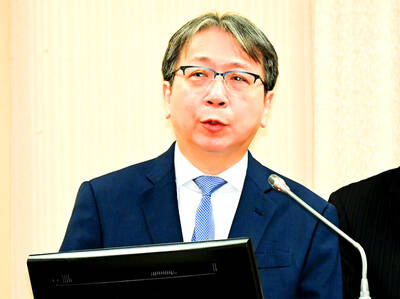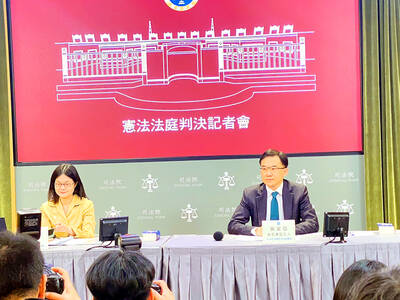The Guardian, London
If you want to start a rumor, how about that Google is going to build its own nuclear power station? The logic is easy. Larry Page, the company's co-founder, reportedly sees "running out of power" as the biggest potential threat to Google, and the electricity needed to run its "server farms" -- tens of thousands of power-hungry computers storing billions of Internet pages -- could soon cost more than the hardware. Partly this is because Google is based in California, where the state solved its 2001 energy crisis by borrowing US$10 billion to buy electricity at massively inflated prices. But the rest of us are heading in the same direction.
We live in a world where the use of chip-based computers and consumer electronics devices is increasing rapidly, while supplies of oil and natural gas are diminishing perhaps even more rapidly. Worse, the threat of global warming means we should now be decreasing our energy use, like the Japanese, not increasing it. And although each individual PC or peripheral may not use much electricity, when you have a billion of them, it adds up.
Powering down
Sadly, it's impossible to say how much power a PC uses without measuring it, because of variables such as the type of motherboard, the speed of the chip and the power of the graphics card. (A fast graphics card can use more power than the processor.) PC power supplies can range from about 150W to about 650W, and will actually draw more than that during peak loads. However, PCs use much less power when idling and the US Energy Star program -- which PC manufacturers have been following since 1992 -- is aiming to get the power consumption on idle below 50-60W.
The simplest approach is to use the PC's power-saving software to turn the screen and hard drive off and then suspend the whole system after a specified time.
The situation is improving thanks to market trends towards flat screens and the use of portables rather than desktop computers. LCDs use much less power than traditional monitors, and by design, most notebooks use less power than most desktops. At the extremes, the 1GHz Pentium M Ultra Low Voltage chip uses only 5W whereas Intel's hottest chip for gaming, the 3.73GHz Pentium 4 Extreme, can consume up to 115W.
However, Intel has done a U-turn on its processor design goals, which should help. The Pentium design drove up clock speeds (and power consumption) to build the fastest chips. In 2002, Intel executives still assured me that "gigahertz is far from over" and looked forward to a 4.7GHz Pentium codenamed Tejas. Last year, however, they announced a new mantra: "performance per Watt."
Alistair Kemp, a spokesman for Intel, says the company has now developed "a new microarchitecture that will be coming out in the second half of this year." New chips will, he says, "reduce average power use quite substantially." The reduction will be from about 95W, for a fast Pentium 4, to about 65W.
Performance per Watt is also important for the arrays of servers in corporate data centers. Luiz Andre Barroso, principal engineer at Google, has already warned that "the possibility of computer equipment power consumption spiraling out of control could have serious consequences for the affordability of computing, not to mention the overall health of the planet."
In an article called "The Price of Performance" in the professional journal ACM Queue, Barroso expressed concern at the cost of providing computers, with electricity overtaking the cost of buying the hardware in the first place.
Running costs are exacerbated because companies generally try to utilize their servers as heavily as possible 24/7, or 8,760 hours a year. Faster processors generate more heat, so computer rooms require extra cooling. This uses more electricity, costing more money.
Of course, there's nothing new about any of this. The late Seymour Cray, the world's greatest supercomputer designer, spent a lot of his time on plumbing. In 1985, he resorted to pumping a non-conducting liquid called Fluorinert over the Cray 2's electronics to cool them. When mainframes ruled the world, IBM packed its mainframe chips in ceramic Thermal Conduction Modules with chilled water flowing through pipes to conduct away the heat. Some of today's high-performance games PCs use similar techniques, and it's still an option for servers -- but no one wants to go back to plumbing.
multiprocessors
Barroso suggests that multiprocessor chips are "the best [and perhaps only] chance to avoid the dire future envisioned above". What has changed recently is that multicore processors -- with more than one processing element on a single die -- have finally entered the mainstream, and many PC manufacturers are now shipping systems with Intel Core Duo processors that deliver more per watt than their forebears.
Indeed, the idea has even reached the home market. Microsoft's Xbox 360 games console has a processor with three IBM PowerPC cores, each of which can run two programming threads: the result is a single chip that can work like six. Sony's forthcoming PlayStation 3 will use an IBM Cell chip with multiple processing elements.
Not even low-power multicore chips will solve the power consumption problem permanently, but they should at least buy us a few years breathing space.
And if people factor the cost of power consumption (and cooling, where required) into their computer purchasing decisions, both for commercial and ecological reasons, this will put pressure on the manufacturers to do even better in the future.

The US government has signed defense cooperation agreements with Japan and the Philippines to boost the deterrence capabilities of countries in the first island chain, a report by the National Security Bureau (NSB) showed. The main countries on the first island chain include the two nations and Taiwan. The bureau is to present the report at a meeting of the legislature’s Foreign Affairs and National Defense Committee tomorrow. The US military has deployed Typhon missile systems to Japan’s Yamaguchi Prefecture and Zambales province in the Philippines during their joint military exercises. It has also installed NMESIS anti-ship systems in Japan’s Okinawa

TRAGEDY STRIKES TAIPEI: The suspect died after falling off a building after he threw smoke grenades into Taipei Main Station and went on a killing spree in Zhongshan A 27-year-old suspect allegedly threw smoke grenades in Taipei Main Station and then proceeded to Zhongshan MRT Station in a random killing spree that resulted in the death of the suspect and two other civilians, and seven injured, including one in critical condition, as of press time last night. The suspect, identified as a man surnamed Chang Wen (張文), allegedly began the attack at Taipei Main Station, the Taipei Fire Department said, adding that it received a report at 5:24pm that smoke grenades had been thrown in the station. One man in his 50s was rushed to hospital after a cardiac arrest

ON ALERT: Taiwan’s partners would issue warnings if China attempted to use Interpol to target Taiwanese, and the global body has mechanisms to prevent it, an official said China has stationed two to four people specializing in Taiwan affairs at its embassies in several democratic countries to monitor and harass Taiwanese, actions that the host nations would not tolerate, National Security Bureau (NSB) Director-General Tsai Ming-yen (蔡明彥) said yesterday. Tsai made the comments at a meeting of the legislature’s Foreign Affairs and National Defense Committee, which asked him and Minister of National Defense Wellington Koo (顧立雄) to report on potential conflicts in the Taiwan Strait and military preparedness. Democratic Progressive Party (DPP) Legislator Michelle Lin (林楚茵) expressed concern that Beijing has posted personnel from China’s Taiwan Affairs Office to its

‘ILLEGAL RULING’: The KMT and the TPP slammed the Constitutional Court judgement, saying it contravened the law and was trying to clear the way for a ‘green dictatorship’ The Constitutional Court yesterday ruled that amendments to the Constitutional Court Procedure Act (憲法訴訟法) passed by the Legislative Yuan last year are unconstitutional, as they contravene due legislative process and separation of powers. The Legislative Yuan on Dec. 20 last year passed amendments stipulating that no fewer than 10 grand justices must take part in deliberations of the Constitutional Court, and at least nine grand justices must agree to declare a law unconstitutional. The Executive Yuan on Jan. 2 requested that lawmakers reconsider the bill, but the Legislative Yuan, under a combined majority of Chinese Nationalist Party (KMT) and Taiwan People’s Party